The Phenom II X4 810 & X3 720: AMD Gets DDR3 But Doesn't Need It
by Anand Lal Shimpi on February 9, 2009 12:00 AM EST- Posted in
- CPUs
Overclocking-
Since all of the new AM3 parts are built off of the same Phenom II die as what we reviewed back in January, we'd expect similar overclocking results. While I worked on performance testing, Gary went to work on overclocking these new Socket-AM3 CPUs. What follows are his first experiences.
We are utilizing the ASUS M4A78T-E motherboard based on the AMD790FX/SB750 chipset for our overclocking tests, this is actually a Socket-AM3 motherboard. The Phenom II X4 810 and X3 720 BE processors are meant for the mid-range market and users are likely to pair them with the 790GX chipset or something similar. We will have additional overclocking results in the near future comparing various AM3 and AM2+ boards along with lower priced components. Our AM3 board selection currently includes the ASUS M4A79T Deluxe (790FX/SB750), ASUS M4A78T-E, and the ASRock M3A790GXH/128M, which upholds their ability to provide high HTT rates for locked processors on the 790GX chipset. We expect additional AM3 boards from MSI, Gigabyte, and others shortly.
We put an emphasis on stability during our testing sessions so we test with real world applications ranging from a variety of games to digital imaging software to various audio/video creation programs, along with the normal OCCT and PCMark Vantage tests. We focus on the type of overclocks that support 24/7 operation with reasonable cooling and the ability to run a multitude of programs without a problem. We are not optimizing for SuperPI or 3DMark records; it's more like trying to keep our bank records safe from a crash (sadly, there's nothing we can do about actual banks crashing).
Overclocking Test Setup
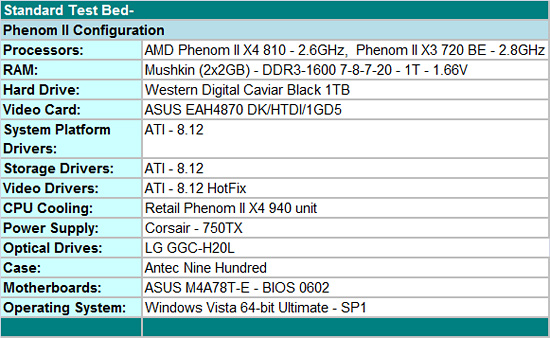
We selected the ASUS EAH4870 DK/HTDI/1GD5 video card for GPU duties. It is a non-reference design that offers improved thermals and acoustics over the standard HD4870 1GB cards in our board choices. The WD Caviar Black 1TB is the hard drive of choice for storage purposes. LG’s GGC-H20L Blu-ray drive fills in for optical duties. Our power supply is Corsair’s 750TX that we used in a couple of recent P45 and Phenom II CrossFire articles. The reason for this is to ensure similar power consumption numbers in our motherboard articles this year. However, in the IG centric motherboard tests we will show additional results with the Thermaltake TR2-430W power supply.
We selected Mushkin’s impressive DDR3-1600 kit to ensure our systems would not be limited by memory speed. We used 4GB in our standard benchmarks with memory set at DDR3-1600 with 7-8-7-18 timings at 1.66V. We will also test with some budget friendly DDR3-1333 from Patriot in the individual motherboard reviews. Our cooling choice is the retail unit from a Phenom II X4 940 as our engineering samples were not shipped with a heatsink/fan. Our clock speeds did not change with improved CPU air-cooling in today's test. However, temps did drop anywhere from 6C~9C at load with the Vigor Monsoon III LT we tested and would highly recommend utilizing an upgraded air cooler for the long term. We utilized Antec’s Nine Hundred case, yes, it is overkill for our uATX boards but we wanted to provide excellent cooling for our setups during overclocking for these particular tests.
Phenom II X3 720 BE Maximum Overclock on Stock Voltages
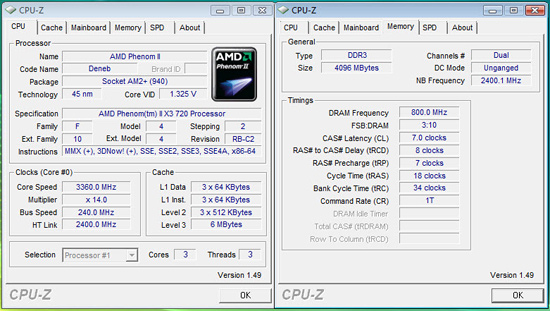
Our maximum overclock on stock Core VID with the X3 720 BE resulted in a 3.36GHz clock speed at a respectable 240HTT clock and Northbridge speed at 2400MHz. Memory speed is set to DDR3-1600 at 7-8-7-18 1T on 1.68V, slightly higher than our stock 1.66V for additional stability in Crysis Warhead. The primary voltages settings were left at auto in the BIOS with it determining a 1.3375V CPU/NB voltage. We tried a variety of CPU multipliers and HTT clock speed and still ended up around 3.3GHz as our maximum clock at the stock Core VID of 1.325V.
Phenom II X3 720 BE Maximum CPU/HTT Overclock
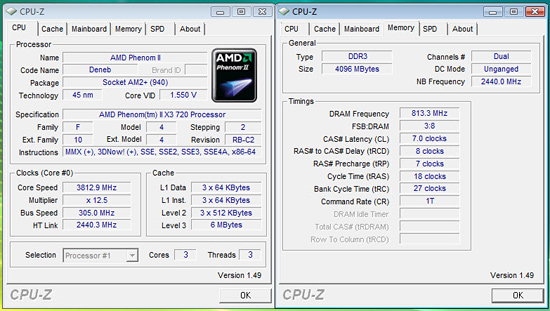
Our maximum overclock for both CPU and HTT speed ended up at a 12.5x305HTT setting. This resulted in a 3.812GHz processor clock speed with Northbridge speed at 2440MHz. We initially set our Northbridge speed to 2745MHz but could not hold stability in several of our benchmarks, regardless of voltage settings. We set Core VID to 1.55V, VDimm to 1.68V, CPU/NB Voltage to 1.4375V, and HT to 1.38V. Memory speed is set to DDR3-1627 at 7-8-7-18 1T. Our best performing and highest CPU/HTT setting was at 13x300 for a 3.90GHz core speed, but we could not hold stability in Crysis Warhead, Cyberlink Power Director 7, or the Movie/TV test in PCMark Vantage x64.
Phenom II X3 720 BE Maximum CPU Overclock
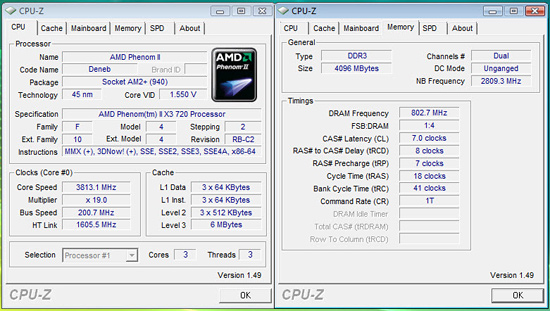
No surprises here based on our results above. Our maximum overclock for both CPU speed ended up at a 19x200HTT setting. This resulted in a 3.813GHz processor clock speed with Northbridge speed at 2809MHz. We set our Core VID to 1.55V, VDimm to 1.66V, CPU/NB Voltage to 1.4375V, and HT to 1.38V. on stock VCore with the X3 720 BE resulted in a 3.36GHz clock speed at a respectable 240HTT clock and Northbridge speed at 2400MHz. Memory speed is set to DDR3-1600 at 7-8-7-18 1T. We also tried the 19.5x200HTT setting for 3.90GHz, but could not hold stability in the applications mentioned above. The system would post at 20x200 easily, but Vista 64 SP1 would always BSOD once entering the OS. It appears from all indications that the AM3 processors have the same 4GHz limitation in Vista 64 with normal cooling methods. We increased VCore to 1.60V and could POST at 4.2GHz but could never enter the OS regardless of other NB speed, HT speed, or voltage settings.
Phenom II X4 810 Maximum Overclock on Stock Voltages
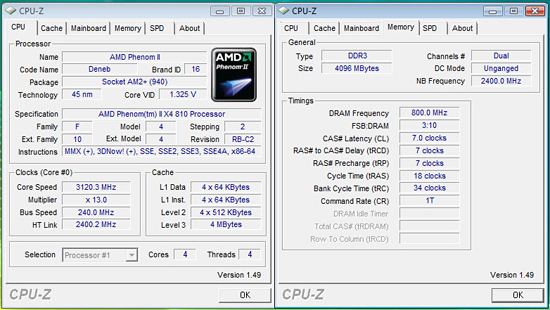
Our top overclock on stock VCore with the X4 810 resulted in a 3.12GHz clock speed at a healthy 240HTT clock and Northbridge speed at 2400MHz. Memory speed is set to DDR3-1600 at 7-7-7-18 1T on 1.66V. We left the primary voltages settings at auto in the BIOS with it determining a rather high 1.3750V CPU/NB voltage. We found through trial and error that a CPU/NB voltage of 1.3325 was stable at this clock speed. Since this CPU is locked, we could not increase the CPU multiplier but did try a variety of lower multipliers and higher HTT clock settings. However, on a stock Core VID and without greatly reducing memory speeds, our final 240HTT clock setting was the best we could accomplish.
Phenom II X4 810 Maximum CPU Overclock
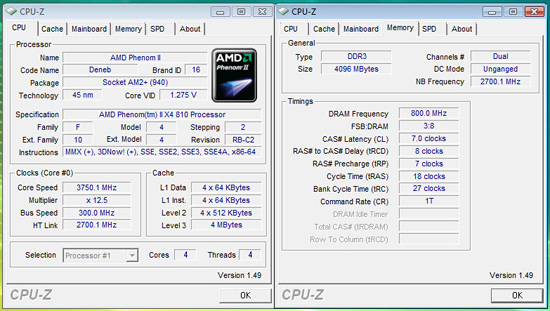
Our maximum overclock on the X4 810 ended with an offbeat 12.5x300HTT setting. This resulted in a 3.75GHz processor clock speed with Northbridge speed at 2700MHz. We tested a variety of combinations and this one resulted in our best CPU speed and overall system performance. We just could not go higher regardless of voltages or HT/Northbridge settings and keep the system stable. We almost had 13x295HTT stable at 3.83GHz but it would consistently fail most of our encoding benchmarks. We set Core VID to 1.55V, VDimm to 1.66V, CPU/NB Voltage to 1.4250V, and HT to 1.38V. One strange item we noticed is that our various reporting tools except TurboV from ASUS would show Core VID fluctuating wildly from 1.455V to 1.62V depending on the application. We checked with our DMM and voltage was at 1.571V on our 1.55V setting. Memory speed is set to DDR3-1600 at 7-8-7-18 1T. We also tossed in our new Corsair Dominator GT DDR3-2000 C7 kit for fun and had an easy time running 5-6-5-18 1T timings at DDR3-1600 with 1.62V on this board.

































77 Comments
View All Comments
Griswold - Monday, February 9, 2009 - link
"We're in the midst of a price war folks, and at a time when the global economy is looking a little shaky this actually works very well for us. Let's recap what's happened."That works very well for us until AMD, despite having a good product portfolio (this includes video cards), goes belly up thanks to this worldwide recession (a little shaky? Where have you been the last couple of months!?).And then what? Back to moon prices courtesy of Intel?
I hope not, but fear the worst. :(
lplatypus - Monday, February 9, 2009 - link
Why does the Ph II 940 system use only 4W more than the 810 at load? This is not consistent with TDPs (125W vs 95W). The HEXUS.net review found a 23W difference under load. Is something wrong here?Axloth - Monday, February 9, 2009 - link
I'd love to see detailed test of impact of cache size per core, because test results in this review are really weird. Something like x4 910 vs x4 810 vs x3 710. Pretty please with sugar on top...ET - Monday, February 9, 2009 - link
Needs more comprehensive testing, period. The results look really strange sometimes. Not only did the 810 sometimes outperformed the 910 significantly, but the 710 consistently beat the 910 in the gaming tests.(So far -- and I haven't read other reviews -- the 710 is looking like a good candidate to replace my aging X2 3800+.)
RadnorHarkonnen - Monday, February 9, 2009 - link
From the rumors ive seen in the web, this will be a pretty cheap cpu.Myt little brother is crying for My 4800 X2 (he always get free upgrades) with 4Gb DDR2.
Just one question, With a Stock VID 1.325 to 1.55 isn't that a little bit aggressive (even with good air cooling), for everyday operation ? I was hoping for a OC up to 3.6Ghz in decent voltage. 3.8Ghz Would be very good, but the voltage seems somewhat too large for day-to-day operation.
Thanks for reading, and replying if you have the time, of course.
Gary Key - Monday, February 9, 2009 - link
On our samples, starting around 3.5GHz you really had to ramp the Core VID. 3.6 required about 1.45V in the BIOS, with droop it was around 1.4375V real on this board. If the retail chips follow the 940, then I would say around 1.425V should be realistic for 3.6GHz on the right board. 1.55V is not outside of AMD's spec and is the limit they have found for air cooling. It is about the same limit we have noticed also for the most part, but these chips are designed to take a lot voltage if you keep them properly cooled.RadnorHarkonnen - Monday, February 16, 2009 - link
I'm already checking prices and availability for this hardware. I'll check the speed bump and the temp bump between 3.5 and 3.6. Thanks for the info Gary.duploxxx - Monday, February 9, 2009 - link
most run 3.4 ghz already on stock vcore@review, you state that there is no performance difference between ddr2-ddr3 but you didn't show anything? Anyhow official statement from AMD is that the ddr3 part bios is not fully ready yet, so I hope you will do a full review later.
Gary Key - Monday, February 9, 2009 - link
"@review, you state that there is no performance difference between ddr2-ddr3 but you didn't show anything? Anyhow official statement from AMD is that the ddr3 part bios is not fully ready yet, so I hope you will do a full review later."AMD told us a couple of weeks ago to concentrate on performance with the AM2+ boards since the AM3 BIOS releases were immature. I received several BIOS releases last week for our AM3 boards and felt safe enough to display numbers with them in the OC section today.
We are still testing and will have comparisons up in the near future. That said, we still have a list of requests back to the motherboard companies to fix. For the most part now, the AM3 boards are usable and clock well. I figure another BIOS spin or two and they should be good to go.
Also, in a best case scenario, AMD had performance improvements of 5% at best in memory bandwidth limited benchmarks with DDR3. Things might change with the 945 hits in a couple of months, but on these processors, there really are not any differences between DDR2 and DDR3 at this point.
Kaleid - Monday, February 9, 2009 - link
Power consumption and framerates at the max stable overclock?